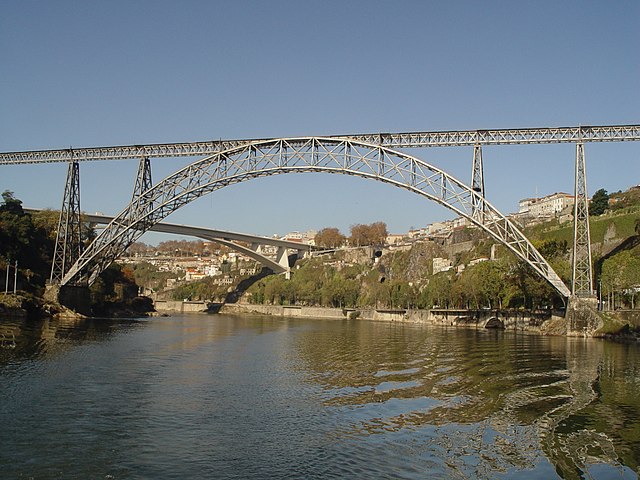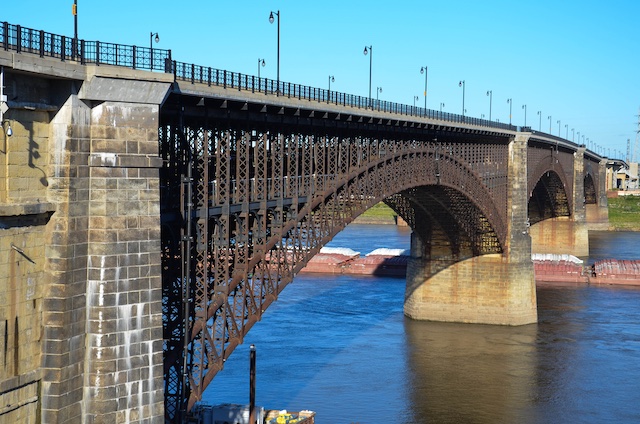|
Today's Opinions, Tomorrow's Reality
A Tale of Two Bridges By David G. Young Porto, Portugal, April 18, 2023 -- The design of bridges in St. Louis and Porto hint at the subsequent economic paths of the United States and Portugal. The beautiful metal span of the Maria Pia Bridge gracefully arches over the deep Douro river gorge on the east side of this city, a silent monument to the early industrial era. Half a world away in St. Louis, the Eads Bridge crosses the muddy lower Mississippi river, its multiple arches spanning more than a mile of water and floodplains. Unlike the elegant but disused Maria Pia built in the same era, the Eads bridge is a gritty traffic-choked workhorse, carrying four lanes of vehicle traffic above and trains on a lower deck.
The choice of old-fashioned wrought iron, not steel for the Maia Pia bridge out was a fateful decision that has parallels in the development of Portugal and the United States. Wrought iron flexes more and is not as strong as steel — an alloy of iron and carbon. While techniques to make steel have been known for many thousands of years, the process was laboriously expensive and the productrion volumes small, long limiting the use of steel to swords and other small precision objects where at strength and rigidity was critical. Only with the discovery of the Bessamer process in 1857 by a British engineer of the same name was bulk steel production possible, and even then it took visionary industrialists to put the technology into practice. Scottish-American industrialist Andrew Carnegie did exactly that with relentless efficiency after the American Civil war. He combined a network of mills in Pennsylvania and Ohio coal country that supplied the steel to make a bridge over the lower Mississippi possible.1 Despite a huge river and floodplain over a mile wide, enormous volumes of water and winter ice flows that ripped at supports, Carnegie’s steel turned that dream into reality when the bridge was constructed from 1867 to 1874. So when the time came to build a bridge over the Douro river in Porto a couple of years later, steel was an established option. But steel was still far more expensive than wrought iron, and the economies of scale for massive and cheap steel production in America’s Ohio Valley were not yet available in Europe. The engineering firm of Eiffel and Co, the same one that would later build the famous tower in Paris, started building its bridge over the deep gorge of the Douro valley in 1876 as a narrow single track railway with an enormous single arch spanning the river. Both the narrowness of the bridge and the relative flexibility of cheaper wrought iron caused the bridge to sway under load, limiting the size, number and speed of trains as they crossed. A new steel reinforced concrete span was built three decades ago, and the Eiffel-built bridge is now a relic of the past. Like the bridge, the surrounding city of Porto is also largely a relic of the past. Made rich by export of port wines from vineyards along the river valley, its labyrinthine streets are lined with architectural gems including baroque churches, gilded age places and stunning art nouveau storefronts. But buildings from the 1920s and later are strikingly few. That’s because of economic crises that surfaced around the turn of the 20th century, and accelerating after the 1910 overthrow of the largely incompetent monarchy in favor of a series of even more incompetent republican governments. A new paper currency, the Portugese Escudo, replaced the Real after the revolution, printing money caused hyperinflation that sent industrialist wealth fleeing overseas. This came to a disastrous climax with a military coup in 1926 and several decades of fascist rule.2 Economic stagnation froze Porto in time, just as a booming St. Louis was razing and replacing its old buildings with gray mid-20th century industrial development ringed by freeway loops and sprawling suburbs. Had St. Louis’ economic peak come a half-century earlier, when architecture was still quaint, it might attract even a fraction of Porto’s booming tourist arrivals. Few tourists wander anywhere near St. Louis’s Eads bridge today, while in Porto an even larger arched iron bridge from 1886 is choked with them. While America’s size, dynamism and efficiency and made it a far wealthier country than Portugal, it left gritty industrial wastelands like St. Louis in its wake. No surprise then, that America's abundant tourist dollars now flow out of the country to Porto rather than the other way around. Notes: 1. Bill of Rights Institute, Andrew Carnegie and the Creation of U.S. Steel, as posted, April 18, 2023 2. BBC News, Portugese Escudo, as posted April 18, 2023 |



